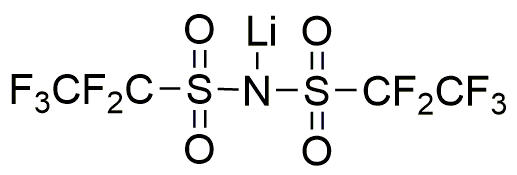Lithium bis(pentafluoroethanesulfonyl)imide is widely utilized in research focused on:
- Advanced Battery Technologies: This compound is a key electrolyte in lithium-ion batteries, enhancing their efficiency and lifespan, making it ideal for electric vehicles and portable electronics.
- Electrochemical Devices: Its unique properties allow for improved performance in supercapacitors and fuel cells, providing higher energy densities and faster charge/discharge rates.
- Organic Synthesis: It serves as a reagent in various organic reactions, facilitating the synthesis of complex molecules in pharmaceuticals and agrochemicals.
- Thermal Stability Applications: The compound is known for its thermal stability, making it suitable for high-temperature applications in aerospace and automotive industries.
- Green Chemistry: Its use in sustainable processes reduces the environmental impact compared to traditional solvents, aligning with the industry's shift towards eco-friendly practices.
General Information
Properties
Safety and Regulations
Applications
Lithium bis(pentafluoroethanesulfonyl)imide is widely utilized in research focused on:
- Advanced Battery Technologies: This compound is a key electrolyte in lithium-ion batteries, enhancing their efficiency and lifespan, making it ideal for electric vehicles and portable electronics.
- Electrochemical Devices: Its unique properties allow for improved performance in supercapacitors and fuel cells, providing higher energy densities and faster charge/discharge rates.
- Organic Synthesis: It serves as a reagent in various organic reactions, facilitating the synthesis of complex molecules in pharmaceuticals and agrochemicals.
- Thermal Stability Applications: The compound is known for its thermal stability, making it suitable for high-temperature applications in aerospace and automotive industries.
- Green Chemistry: Its use in sustainable processes reduces the environmental impact compared to traditional solvents, aligning with the industry's shift towards eco-friendly practices.
Documents
Safety Data Sheets (SDS)
The SDS provides comprehensive safety information on handling, storage, and disposal of the product.
Product Specification (PS)
The PS provides a comprehensive breakdown of the product’s properties, including chemical composition, physical state, purity, and storage requirements. It also details acceptable quality ranges and the product's intended applications.
Certificates of Analysis (COA)
Search for Certificates of Analysis (COA) by entering the products Lot Number. Lot and Batch Numbers can be found on a product’s label following the words ‘Lot’ or ‘Batch’.
*Catalog Number
*Lot Number
Certificates Of Origin (COO)
This COO confirms the country where the product was manufactured, and also details the materials and components used in it and whether it is derived from natural, synthetic, or other specific sources. This certificate may be required for customs, trade, and regulatory compliance.
*Catalog Number
*Lot Number
Safety Data Sheets (SDS)
The SDS provides comprehensive safety information on handling, storage, and disposal of the product.
DownloadProduct Specification (PS)
The PS provides a comprehensive breakdown of the product’s properties, including chemical composition, physical state, purity, and storage requirements. It also details acceptable quality ranges and the product's intended applications.
DownloadCertificates of Analysis (COA)
Search for Certificates of Analysis (COA) by entering the products Lot Number. Lot and Batch Numbers can be found on a product’s label following the words ‘Lot’ or ‘Batch’.
*Catalog Number
*Lot Number
Certificates Of Origin (COO)
This COO confirms the country where the product was manufactured, and also details the materials and components used in it and whether it is derived from natural, synthetic, or other specific sources. This certificate may be required for customs, trade, and regulatory compliance.

